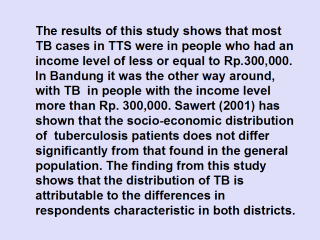| front |1 |2 |3 |4 |5 |6 |7 |8 |9 |10 |11 |12 |13 |14 |15 |16 |review |
 |
Specifically in TTS
almost all of the respondents (97%) have low income level while in Bandung
less than 40% of the respondents were in low income. These might reflect the
fact that health care is still a luxury for poor people. However, since DOTS
program provided free treatment it might be that the susceptibility to
disease is higher in people who are less well nourished. TB cases in both districts were found mainly in people who have only elementary level education. This finding is in line with the study by Kustijadi (2000) who found that in 74.5% of the TB cases were people with low education level. Ignorance of the disease might be one reason of the high percentage in this group. However, this finding might also be associated with the high numbers of elementary educated people in the sample. In TTS almost 50% of the cases were to be found to be the head of the household, followed by their spouse (35%) and their children (8%). This showed the importance of household contacts with cases of TB. However, it should be noted that in Indonesia member of household are usually comprised not only of the nuclear family but extended family as well. It is also common to have two or more families live together in the same house. This factor further contributes to the ease of transmission of the disease. |